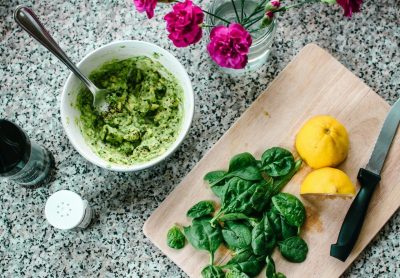This week I wanted to talk about one of my personal non-negotiables, eating dark leafy greens daily. We’ll chat about:
- Why it’s a great nutrition goal if you’re ready to level up digestive, brain, metabolic or immune health.
- What are dark leafy greens
- Easy ways to add them in to what you’re already cooking
- Recipe Ideas
Why dark leafy greens?
To recap what I started chatting about on Instagram the other day, dark leafy greens have a bunch of key nutrients that take a healthy diet from good to great! Particularly on an anti-inflammatory diet, we want to ensure that we’re choosing plenty of dark or bright foods each week (more on this in next week’s email). The darker the pigment, the more dense the anti-inflammatory or anti-oxidant phytonutrients. Most anti-oxidants are “colour coded” and so looking for dark/bright coloured fruits and veggies is a quick and dirty way to ensure you’re packing them in.
Lutein: Lutein, is excellent at lowering oxidative stress (key for auto-immune conditions, PCOS, chronic gut issues, or ongoing physical/lifestyle stress) and seems to help prevent or repair atherosclerosis. Why is atherosclerosis important? It is the damage of our blood vessels and development of plaques in those damaged areas that can lead to heart attack or stroke over time. Some damage will happen (because life happens), and getting enough key anti-oxidant nutrients can help to repair and reverse it.
Fibre: Most dark leafies are a great way to add food based fibre for a healthy gut. Think you get enough with fibre pills or supplements like Metamucil? Think again. We now know that diversity of fibre (getting different types of plants each week) is as important as getting enough fibre to build a strong and resilient gut bacteria community to support your digestion, absorption and immune system. The easiest way to do this is by working several different types of plants into your meal plan each week.
If you struggle with bloating, Irritable Bowel Syndrome, or Small Intestinal Bacterial Overgrowth some of the cruciferous dark leafy greens like kale may not sit well with you for now. Make sure you work with someone to repair the issue so you can add them back when your gut is healed.
Magnesium: One of my “pet” nutrients, this mineral is attached to Chlorophyll, another green molecule. Magnesium is involved in over 300+ DNA repair pathways that slow cellular aging. Why do we care about cellular aging? As cells “age” they accumulate damage to the DNA, and that damaged DNA gets passed down to new cells over and over again. This accumulated damage causes cells that don’t function as well (skin, muscle, and immune) or don’t “die” when they’re supposed to (leading to cancerous cells). Slowing the cellular aging process improves everything from skin and brain health to helping prevent or delay the big 3 aging related diseases that catch up with most of us (like Cancer, Diabetes, and Heart Disease). This is something that means the world to me after almost a decade in Cancer care, and as someone who wants to be fit, exploring the world, and adventuring well into my golden years!
What are leafy greens?
Here are some examples, but if it’s green and leafy but not on the list – it absolutely counts!
- Kale
- Arugula
- Spinach (baby and “mature”)
- Spring or Field Mix
- Bok Choy
- Gai Lan
- Mustard, turnip, carrot and other root veggie “greens”
- Collard greens (make a great low carb “wrap”)
- Mint, parsley, cilantro, basil and other leafy fresh herbs
- Romaine and other dark/bright lettuces (skip the iceberg unless it’s added for crunch)
- Rapini
- Swiss and Rainbow Chard
- Many others!
Easy Swaps
Just want to squeak in some nutrients to foods you already enjoy? Awesome, that’s my favourite strategy.
- Toss spinach, arugula, kale or wiltable greens in soups, stews.
- Put wiltable greens underneath your leftovers when you reheat them. They disappear so quickly, you hardly know they’re there.
- Add milder greens (fresh or frozen) to smoothies. Start with a small handful to see what you like.
- Swap hardier lettuces like butter or kale in for your usual wrap!
- Try collard wraps – they require a little prep but are a fun and sturdy way to veggie wrap your lunch.
- Top pizzas or flatbreads with arugula after cooking
- Add greens to your omelette or frittata (or take the lazy route like me and just pop them underneath your eggs as they’re frying).
- Chopped chard, spinach or kale added to tomato sauce ups the nutrition and flavour
- Use lettuce leaves like Romaine as “boats” to carry toppings like meat, cheese or hummus for a handy snack in place of crackers (thanks C.D. for that creative idea!).
Recipe Ideas
Want some fun new ways to up your leafy greens? Here are some of my favourites.
- Sauteed greens are a great way to eat a LOT of greens with very little fuss. Here are some ideas!
- Steamed Greens with Honey Soy Sesame dressing.
- A fresh take on wraps! Squeeze in a little leftover protein to boost up what the hummus offers and you’ve got a fresh and filling lower carb meal. Hummus Collard Wraps
- This is a favourite one for cozy, low fuss nights. And chard is cheap and plentiful at markets in the summer. One pan sausage, chard and cannellini beans.
- Pomegranate, pecan and mixed green salad – simple and fresh!
- Massaged kale salad sounds weird, but is a great way to make kale more tender (and soak up even more flavour). Give it a go with this one from Minimalist Baker or this flavour and crunch packed one from one of my favourite spots for inspo, the Real Food RDs.
- Bok Choy holds up to the grill, making it an easy weeknight veggie side when you just don’t want another salad. Asian Grilled Bok Choy.
I hope you find these tips and recipes helpful to squish just a little more dark leafy greens into your life. Like all your nutrition habits, you’ll find the more you do it the easier and more instinctive it becomes. You’ll just have to use meal planning or your non-negotiables tracking sheet to get over the initial hump.
Need some help getting your meals for the week balanced and prepared? If you’d like to receive our free Meal Planning Getting Started Guide AND get in on our weekly emails about all things nutrition so you can get clarity and confidence on what you’re eating, join us here!







